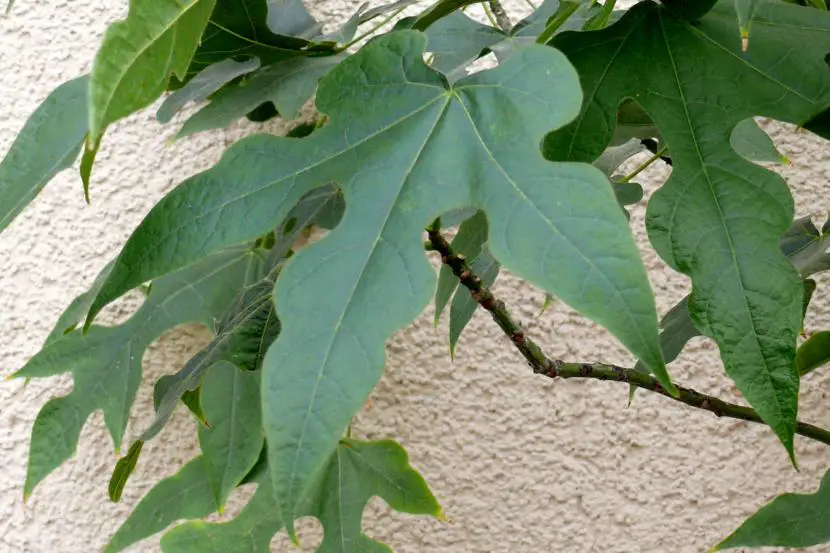
The genus of trees brachychiton It is increasingly used in gardening due to its great ornamental beauty and its drought resistance. It comprises about 30 species native to the Australian continent. Although most are evergreen, we can also find some deciduous. They can grow to a height of 10m, have a trunk thickness of up to 1m, and a typical wide crown of trees from colder regions with a diameter of up to 4m.
Today we are going to introduce you to four of the species that more easily you will find in nurseries: Brachychiton populneus, Brachychiton acerifolius, Brachychiton rupestris y Brachychiton Bidwillii..
Brachychiton populneus

The Brachychiton populneus It is undoubtedly the ideal candidate for gardens with a warm climate and low rainfall. Fast growing, it is approximately 6-7 meters tall, with a crown diameter of up to 2m, evergreen leaves and a trunk thickness of 30-35cm. In addition to being very resistant to drought, it has also shown to have the necessary resistance to survive fire.
They have a very interesting peculiarity, and that is that when they are young and their trunks begin to lignify, said trunk is green-brown in color. As that trunk grows taller may turn more greenish in colorand once the specimen has reached adulthood, it can turn brown (wood).

The flowers only come out in the adult specimens, approximately when the tree has reached 4-5m. It is resistant to pruning, but it is more advisable not to prune itas it may lose ornamental value.
In gardening it is used as an urban tree, and in xero-gardens well as an isolated specimen or forming groups.
Brachychiton acerifolius

The Brachychiton acerifolius It is possible that it is the most used of all, as its ornamental value is undeniable. It is a very beautiful deciduous tree ideal for medium-large gardens, as it grows to a height of 15m with a crown of up to 4m in diameter. The trunk can present a greenish-brown color that, combined with the red of its flowers, will be a spectacle of spring.
The leaves may be reminiscent of some species of maples, hence their species name:
- acer: referring to the genus of deciduous trees commonly called maples (acer sp)
- folius: referring to the leaves

The leaves as in the rest of species of its genus they are very variable. What does not change is the color: dark green. Its growth is fast, and its life expectancy is long. However, it does not resist drought very well (except if it is an adult and adapted specimen). Prefers periodic waterings.
It is a good option if you want a tree that gives some shade in summer.
Brachychiton rupestris

The Brachychiton rupestris It has a bottle-shaped trunk with a thickness of approximately 1m, and a height of 10 meters. It is a very ornamental species that draws a lot of attention especially to collectors, or to those who have gardens of cacti and succulent plants, since they form a combination that is easily reminiscent of the habitat from which many cactus and caudiciform plants originate.
It does not grow as fast as Brachychiton populneusand it may take several years to thicken the trunk, but due to its drought resistance well worth the wait.

The leaves, which are perennial, of the youngest specimens can be very different from those of the adult specimens. It is something normal that also occurs in other species, such as the one mentioned above: Brachychiton populneus.
This is a tree that is not recommended to prune either, but yes to water at least during the first and second year to help you develop a strong root system.
Brachychiton Bidwillii.

The Brachychiton Bidwillii. It is a small tree up to 5-6m, a crown diameter of 2m, and an evergreen. Its growth is fast. From this list it is the Brachychiton species that is most difficult to see in nurseries. Something that we hope will change, since its maintenance is similar to that of the other species of the genus.
Its red flowers with 5 petals, they have a very soft touch.

You need regular waterings, especially if you are young. It’s a little tree ideal for small gardens warm or slightly temperate climate.
Which of the four did you like the most?

